Have you ever wondered where did dairy cows come from? Join me as we explore the fascinating origins of these magnificent creatures.
- Dairy cows, including the Holstein and Jersey breeds, originated in Europe.
- The Holstein breed originated in the Netherlands through crossbreeding of black animals from the Batavians and white animals from the Friesians.
- Holstein cattle were brought to the U.S. in the 19th century by Winthrop Chenery, leading to the establishment of Holstein lines in the country.
- Jersey cows originated from the Isle of Jersey, located off the coast of France and in the English Channel.
- Jersey cattle are one of the oldest breeds, having been brought to England in the 1740s and to the U.S. in the 1850s.
- Both Holstein and Jersey cattle have made significant contributions to the dairy industry, particularly in terms of milk production.
The History of Holstein Cows: From the Netherlands to the United States
The Holstein breed, known for its black and white markings, has a rich history that dates back centuries to the Netherlands. These iconic cows originated around 2,000 years ago through crossbreeding of black animals from the Batavians and white animals from the Friesians. Over time, the breed developed into what we now know as Holstein cattle.
In the 19th century, Holstein cows made their way to the United States thanks to the efforts of a Massachusetts man named Winthrop Chenery. Chenery imported several Holstein bulls and cows, establishing the Holstein lines in the country. Since then, Holsteins have become the most popular breed of dairy cows in the US, known for their high milk production and adaptability.
Their distinct black and white markings make Holstein cows easily recognizable, and their ability to produce large quantities of milk has made them invaluable to the dairy industry. In fact, Holsteins are responsible for the majority of milk production in the United States today.
“Holstein cows have revolutionized the dairy industry with their exceptional milk production capabilities. They are a breed of milk production powerhouses, providing the high milk yields that meet the demands of consumers.” – Dairy industry expert
The legacy of Holstein cows continues to thrive, as they remain a symbol of dairy farming and a testament to the success that can be achieved through selective breeding and innovation.
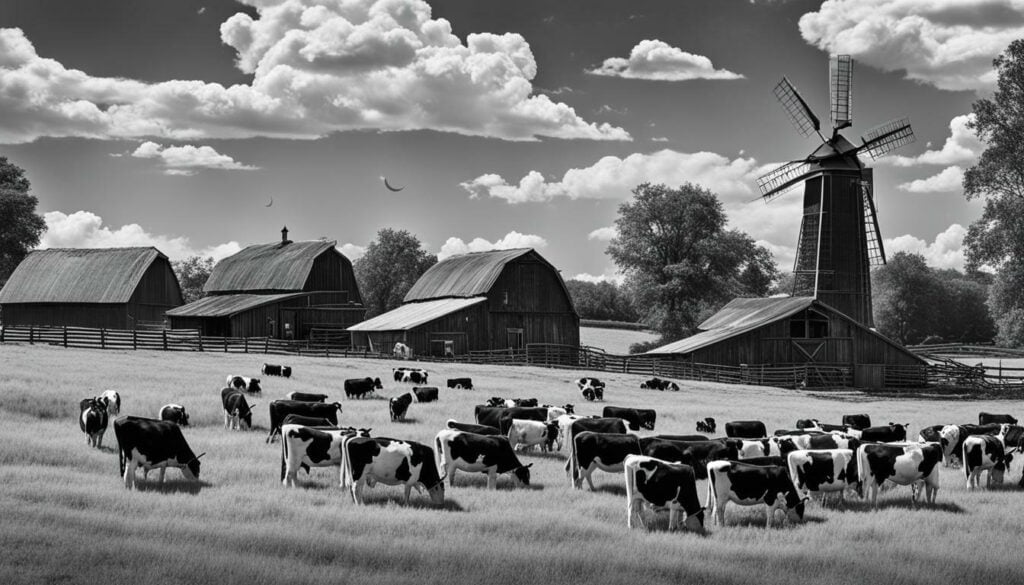
| Breed | Origin | Distinctive Features |
|---|---|---|
| Holstein | Netherlands | Black and white markings |
| Jersey | Isle of Jersey | Smaller bodied |
Jersey Cows: An Ancient Breed from the Isle of Jersey
The Jersey cow, with its gentle temperament and distinct brown coat, can be traced back to the Isle of Jersey in the English Channel. Known for their smaller size and adaptability, Jersey cows are one of the oldest breeds of cattle and have a rich history in the dairy industry. These beautiful cows have been a part of farming traditions for centuries, providing farmers with high-quality milk and playing a crucial role in dairy production.
The exact origins of the Jersey breed before the 1800s remain somewhat mysterious, but historical records suggest that they were brought to England from the Isle of Jersey in the 1740s. These cows caught the attention of farmers in the United States, and in the 1850s, they were brought across the Atlantic to American shores. Since then, Jersey cows have become an integral part of dairy farming in the U.S., known for their excellent milk production and adaptability to various climates.
One of the distinguishing features of Jersey cows is their smaller size. As mature adults, they typically weigh around 1,000 pounds, making them more compact compared to other breeds. However, what they lack in size, they make up for in milk quality. Jersey cows produce milk with a high butterfat content, making it ideal for the production of butter, cream, and cheese. Their milk is also known for its rich taste, often described as creamy and flavorful.
| Jersey Cows | Key Facts |
|---|---|
| Origin | Isle of Jersey, English Channel |
| Introduced to England | 1740s |
| Introduced to the U.S. | 1850s |
| Breed Characteristics | Smaller bodied, gentle temperament, distinct brown coat |
| Milk Production | High butterfat content, rich taste |
Today, Jersey cows continue to be valued for their unique qualities and contributions to the dairy industry. Their smaller size makes them well-suited for smaller farms and grazing in diverse landscapes. The adaptability of Jersey cows allows them to thrive in a range of environments, from pastures to mountainsides. As the demand for high-quality milk and dairy products grows, the legacy of the Jersey breed remains strong, with farmers appreciating their rich history and the valuable role they play in sustaining the dairy industry.

The ancient heritage of Jersey cows is a testament to their strength and endurance. From the shores of the Isle of Jersey to farms around the world, these cows have left an indelible mark on the dairy industry. Their contribution to milk production, coupled with their gentle temperament and distinctive appearance, has made them a favorite among farmers and consumers alike. Whether grazing on lush pastures or lounging in the sun, Jersey cows continue to inspire awe and admiration for their timeless beauty and the delicious milk they produce.
Contributions to the Dairy Industry: Milk Production and More
Holstein and Jersey cows have played a vital role in the dairy industry, making significant contributions to milk production and beyond. These two breeds, with their unique characteristics and rich history, have shaped the landscape of dairy farming and continue to be of utmost importance to farmers worldwide.
When it comes to milk production, Holstein cows are unparalleled. Known for their high milk yield, these breed of cows are true milk production powerhouses. With their larger size and exceptional genetics, Holsteins are capable of producing large quantities of milk, making them a preferred choice for dairy farmers looking to maximize productivity. Their milk productivity has greatly contributed to meeting the demands of the dairy industry, providing a steady supply of milk for consumers.
On the other hand, Jersey cows, although smaller in size, are no less impressive when it comes to milk production. Despite their smaller bodies, these cows are known for their ability to produce milk with a higher butterfat content, resulting in a richer and creamier dairy products. The quality of their milk, coupled with their adaptability to a wide range of climates and conditions, make Jersey cows highly valuable to the dairy industry.
The Impact on the Agriculture Industry
The contributions of Holstein and Jersey cows extend beyond milk production. Cattle breeding, driven primarily by these two breeds, has had a profound impact on the agriculture industry as a whole. The dairy industry, in particular, has benefited from the advancements and innovations in cattle breeding techniques, resulting in improved milk production, overall herd health, and sustainable farming practices.
The dairy industry, supported by Holstein and Jersey cows, continues to evolve and adapt to meet the changing needs of consumers and the challenges of the modern world. From embracing sustainable farming practices to exploring innovative approaches in dairy farming, the future of dairy cows looks promising. As the demand for organic and ethically sourced dairy products grows, the industry will continue to rely on Holstein and Jersey cows to provide high-quality milk that meets the diverse needs of consumers.

| Breed | Milk Production | Butterfat Content |
|---|---|---|
| Holstein | High | Lower |
| Jersey | Moderate | Higher |
It is clear that both Holstein and Jersey cows have made significant contributions to the dairy industry, whether it be through their exceptional milk production capabilities or their adaptability to varying farming conditions. As we celebrate the heritage of these remarkable breeds, let us recognize the impact they have had on the dairy industry and the crucial role they continue to play in providing us with the milk and dairy products we enjoy every day.
The Arrival of Holstein Cows in the United States
In the 19th century, Winthrop Chenery brought Holstein cows from the Netherlands to the United States, laying the foundation for the establishment of Holstein lines in the country. These black and white beauties made their way across the Atlantic, ushering in a new era of dairy farming in America.
Chenery, a Massachusetts man with a passion for agriculture, recognized the potential of Holsteins and saw an opportunity to improve milk production in the United States. He imported several Holstein cows, which caught the attention of farmers and breeders across the nation.
“Holsteins quickly gained popularity for their high milk yield and adaptability to different climates,” says Chenery. “They were larger, sturdier, and more efficient milk producers compared to other breeds at that time.”
As interest in Holsteins grew, so did the establishment of Holstein lines in the United States. Dedicated breeders worked tirelessly to select and breed Holsteins with desirable traits, such as improved milk production and conformation. This led to the development of Holstein bloodlines that would become the foundation of the modern Holstein breed we know today.
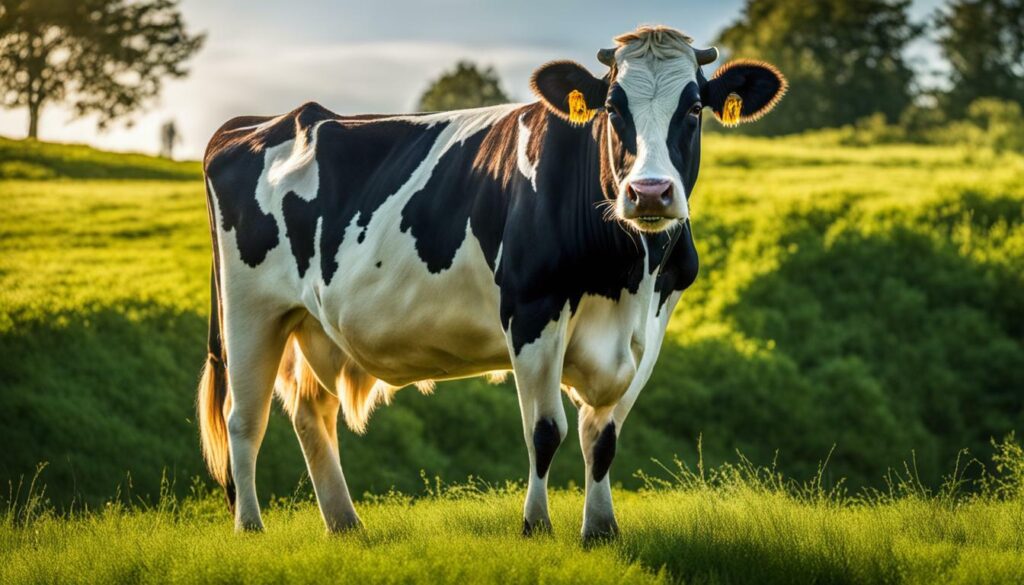
The arrival of Holstein cows in the United States had a transformative effect on the dairy industry. Their exceptional milk production capabilities, coupled with their adaptability and overall hardiness, made them a valuable asset to farmers across the nation. Today, Holsteins continue to be one of the most widely recognized and sought-after breeds in the dairy industry, providing a steady supply of milk to meet the ever-growing demands of consumers.
Journey from the Isle of Jersey to America: The Story of Jersey Cows
In the 1850s, Jersey cows made their way from the Isle of Jersey to the United States, bringing with them a rich history and a legacy of excellence in dairy production. These cows, known for their smaller size and distinctive features, quickly captured the attention of American farmers and became an integral part of the country’s dairy farming industry.
The journey of Jersey cows began centuries earlier on the Isle of Jersey, a small island located between France and England. While the exact history of the breed before the 1800s remains somewhat mysterious, it is believed that Jersey cows were brought to England in the 1740s. They eventually found their way to American shores in the 1850s, where their unique characteristics and exceptional milk production abilities were highly valued.
Jersey cattle are typically smaller in size compared to other breeds, with mature adults weighing around 1,000 pounds. Despite their smaller stature, Jersey cows are powerhouses when it comes to milk production. They are known for their ability to produce milk with a high butterfat content, making it ideal for producing rich and flavorful dairy products.
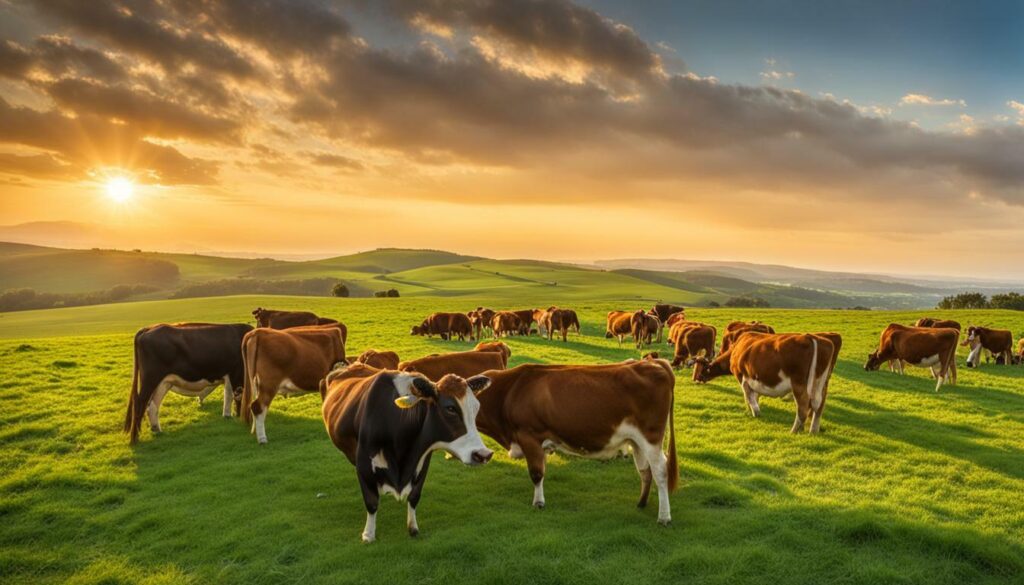
The rich history of Jersey cows and their impact on American dairy farming is a testament to their exceptional quality and versatility. Their ability to thrive in various climates and produce high-quality milk has made them a valuable asset in the dairy industry. Today, Jersey cows continue to play a vital role in dairy production, contributing to the wide variety of delicious dairy products enjoyed by people around the world.
Holstein Cows: A Breed of Milk Production Powerhouses
Holstein cows are renowned for their exceptional milk production, making them a breed of choice for dairy farmers seeking high yields and productivity. Originating in the Netherlands around 2,000 years ago, Holsteins are a result of crossbreeding black animals from the Batavians and white animals from the Friesians. Their journey to the United States began in the 19th century when Winthrop Chenery, a Massachusetts man, brought Holstein cattle to the country, leading to the establishment of Holstein lines in America.
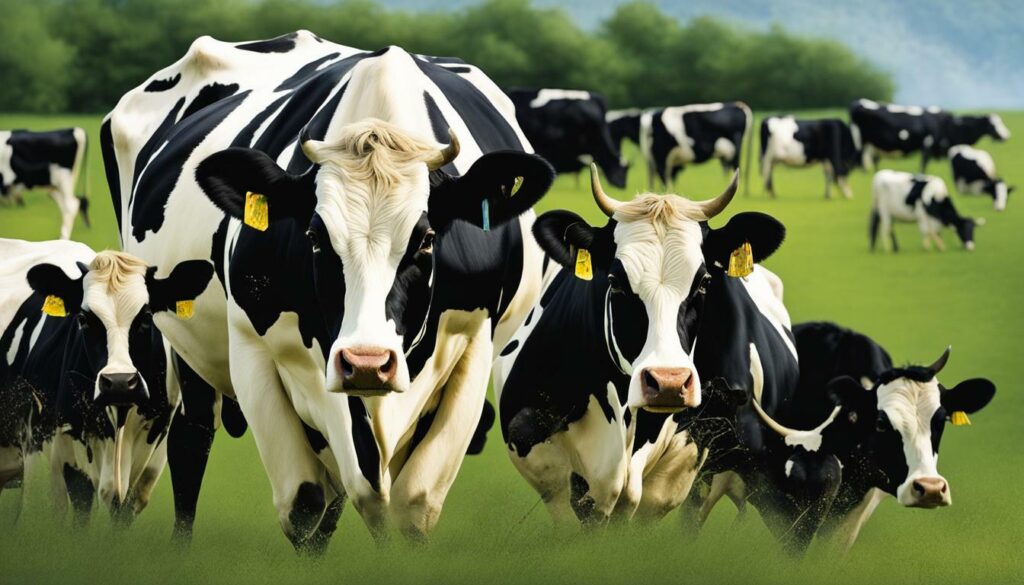
These remarkable cows have left a lasting impact on the dairy industry with their ability to produce large quantities of milk. With their characteristic black and white markings, Holsteins not only dominate the milk production charts but also possess excellent milk productivity. Their genetic makeup, coupled with efficient feeding and management practices, has enabled them to achieve high milk yields, ensuring a steady supply of milk for consumers worldwide.
| Key Features | Benefits |
|---|---|
| Exceptional milk production | A steady supply of milk for consumers |
| Efficient feeding and management | High milk yield and productivity |
| Genetic superiority | Consistent milk production capabilities |
Holstein cows have become synonymous with milk production powerhouses, with their ability to meet the demands of the dairy industry. As the largest dairy breed worldwide, they continue to play a crucial role in the supply of milk and dairy products to the global market. The Holstein’s exceptional milk production, coupled with their adaptability and resilience, make them an invaluable asset to dairy farmers around the world.
Jersey Cows: The Small But Mighty Milk Producers
Don’t let their smaller size fool you – Jersey cows are mighty milk producers, contributing to the dairy industry with their rich and creamy milk. Although they may not be as large as Holstein cows, Jersey cows more than make up for it with their impressive milk yield. These smaller bodied bovines are known for their ability to produce high-quality milk, making them highly valued in the dairy industry.
The origins of Jersey cows can be traced back to the Isle of Jersey, situated off the coast of France and in the English Channel. Their exact history before the 1800s remains somewhat mysterious, but they are considered one of the oldest breeds of cattle. Jersey cows were brought to England in the 1740s and later found their way to the United States in the 1850s, where they left a lasting impact on American dairy farming.

Jersey cows are not only known for their milk production but also for the quality of the milk they produce. The milk of Jersey cows is renowned for its rich flavor and high butterfat content, making it ideal for producing butter, cheese, and other dairy products. Additionally, their smaller size makes them easier to handle and manage, making them a popular choice for small-scale dairy farming operations.
In summary, while Jersey cows may be smaller in stature, they are certainly not lacking in milk production ability. These small but mighty milk producers have made significant contributions to the dairy industry with their wonderful milk, adding flavor and richness to dairy products around the world.
The Impact on the Agriculture Industry
The presence of dairy cows, particularly Holstein and Jersey breeds, has had a profound impact on the agriculture industry, specifically in terms of milk production and cattle breeding. These breeds have become the backbone of dairy farming, providing a consistent and reliable source of milk for various dairy products consumed worldwide.
The milk production capabilities of Holstein cows, known for their high milk yield, have revolutionized the dairy industry. With their larger size and higher milk productivity, Holsteins have become the breed of choice for commercial dairy operations. Their ability to produce large quantities of milk has contributed to the growth and profitability of the dairy industry, meeting the increasing demand for dairy products.
On the other hand, Jersey cows have made their mark in the agriculture industry with their smaller bodies and exceptional milk production abilities. Despite their smaller size, Jersey cows are known for producing milk with high butterfat content, making it ideal for cheese and butter production. Their milk is also sought after for its rich flavor, making it a favorite among consumers who appreciate the taste and quality of dairy products.
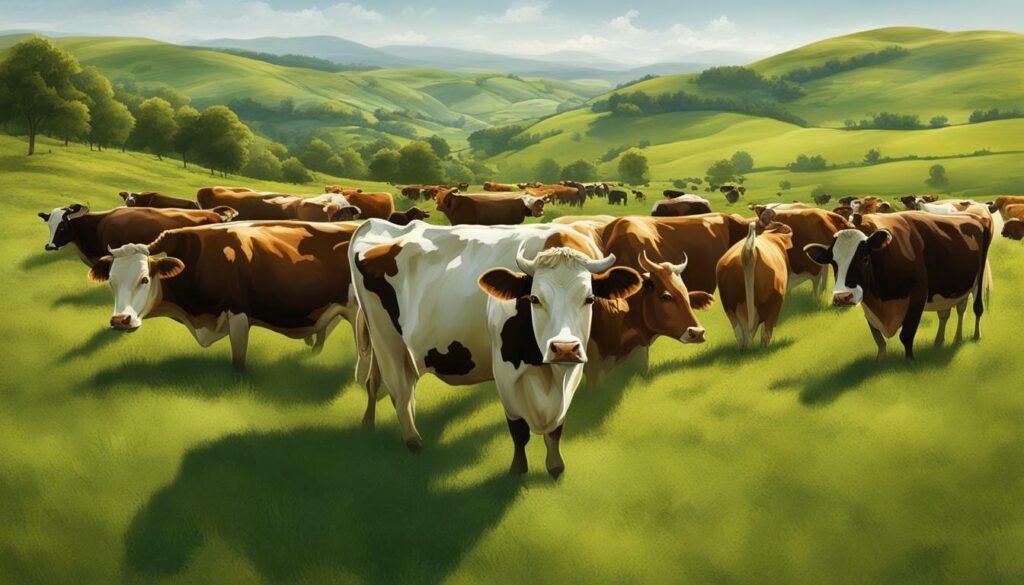
Furthermore, the presence of dairy cows has positively influenced cattle breeding practices in the agriculture industry. Farmers and breeders have dedicated their efforts to improving the genetics and traits of dairy cows, resulting in the development of highly productive and efficient herds. Through selective breeding, farmers can enhance milk production, adaptability to different environments, and overall health and well-being of the animals, ensuring the sustainability and success of dairy farming for future generations.
| Breed | Milk Production | Butterfat Content |
|---|---|---|
| Holstein | High | Lower |
| Jersey | Moderate | Higher |
In conclusion, the presence of Holstein and Jersey dairy cows has had a profound impact on the agriculture industry, particularly in terms of milk production and cattle breeding. These breeds have not only met the increasing demand for dairy products but have also contributed to the ongoing development and innovation in the industry. Through their exceptional milk production abilities and unique genetic traits, Holstein and Jersey cows have shaped the dairy industry into what it is today, providing us with the milk and dairy products we enjoy.
The Future of Dairy Cows: Sustainability and Innovation
As the dairy industry evolves, sustainable practices and innovative methods are shaping the future of dairy farming and the well-being of our beloved cows. It is essential to prioritize the sustainability of dairy operations to minimize the impact on the environment and ensure the longevity of the industry.
One approach that is gaining traction is the adoption of organic dairy farming. Organic dairy farms prioritize the use of organic feed and forage, avoiding the use of synthetic fertilizers, pesticides, and antibiotics. This not only promotes the health and well-being of the cows but also reduces the environmental footprint of dairy farming. Consumers are increasingly seeking out organic dairy products, making this a promising avenue for the future.
| Sustainable Practices in Dairy Farming | Innovative Methods in Dairy Farming |
|---|---|
|
|
Innovation is also driving progress in dairy farming, with new technologies and practices being developed to enhance efficiency and animal welfare. Precision agriculture technologies, such as wearable devices and automated milking systems, enable farmers to monitor the health and behavior of their cows more closely. This allows for early detection of any issues and ensures that individual cow’s needs are met.
“As the dairy industry evolves, sustainable practices and innovative methods are shaping the future of dairy farming and the well-being of our beloved cows.”
The future of dairy cows lies in a combination of sustainable practices and innovative approaches. By prioritizing the health and welfare of the animals, reducing environmental impact, and embracing new technologies, the dairy industry can thrive while ensuring a sustainable future for generations to come.

Dairy cows, with their remarkable milk production capabilities, have a significant global impact, shaping the world market for dairy products. These versatile animals play a crucial role in meeting the growing demand for milk, cheese, butter, and other dairy products.
According to industry data, milk production from dairy cows has been steadily increasing over the years. In 2020 alone, global milk production reached a staggering 843 million metric tons. This abundant supply of milk has allowed countries around the world to meet the nutritional needs of their populations while also fueling the dairy industry’s growth.
Furthermore, the impact of dairy cows extends beyond just milk production. These animals also contribute to the economy by generating employment opportunities in the dairy farming sector. From farmers and herders to milk processors and distributors, countless individuals rely on the dairy industry for their livelihood.
In addition to their economic significance, dairy cows are deeply ingrained in various cultures and traditions worldwide. For centuries, dairy products have been an essential part of many cuisines, from creamy French cheeses to refreshing Indian lassi. The cultural significance of dairy cows is evident in the way they are celebrated through festivals, rituals, and even artistic expressions.
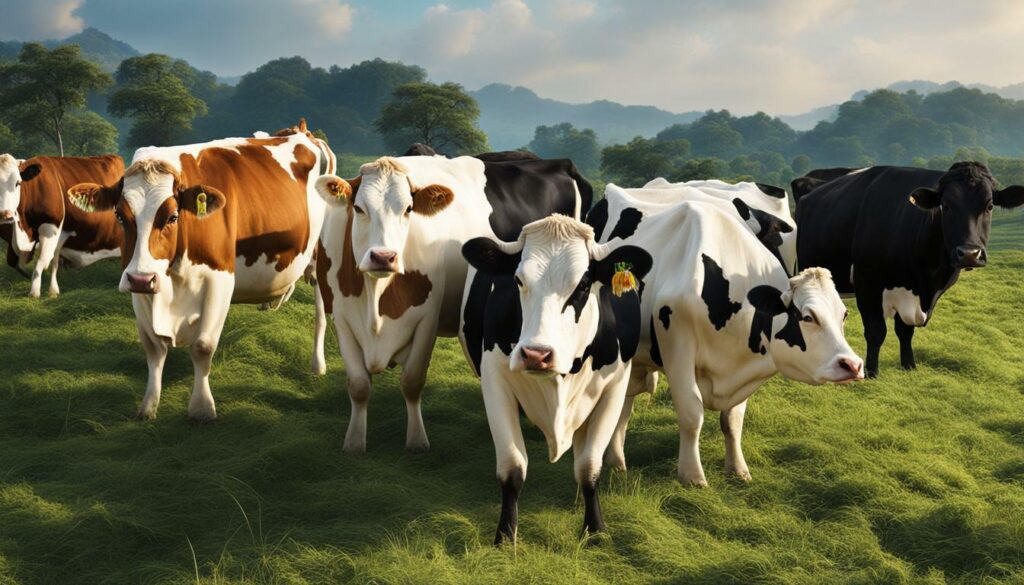
| Country | Milk Production (in million metric tons) |
|---|---|
| United States | 101.4 |
| India | 190.6 |
| China | 34.6 |
| Russia | 31.9 |
As the demand for dairy products continues to grow, the global dairy industry faces challenges in ensuring sustainability and meeting evolving consumer preferences. Farmers and researchers are exploring innovative practices to minimize environmental impacts and enhance animal welfare while maintaining high milk productivity.
In conclusion, the global impact of dairy cows cannot be understated. From providing a vital source of nutrition to driving economic growth and preserving cultural traditions, these remarkable animals have shaped the world market for dairy products and will continue to play a crucial role in the future of the dairy industry.
The Cultural Significance of Dairy Cows
Dairy cows hold a special place in various cultures, with their milk products and farming traditions contributing to the fabric of societies around the world. These gentle animals have been revered and relied upon for centuries, providing milk that is not only a staple in many diets but also the foundation for a wide range of delicious dairy products.
In many agricultural communities, the presence of dairy cows is deeply ingrained in the local culture. From the early morning milking routines to the traditional methods of cheese and yogurt production, these farming traditions have been passed down through generations, fostering a sense of pride and identity. For example, in countries like Switzerland, the cow is a symbol of the rural landscape and plays a significant role in cultural festivals and parades.
The milk products derived from dairy cows are not only nourishing but also hold cultural significance. From creamy butter and rich cheeses to silky yogurt and decadent ice cream, these culinary delights have become iconic in many cuisines around the world. The flavors and textures they provide are not only enjoyed daily but also celebrated during special occasions and festivities.

The role of dairy cows goes beyond food, extending to their contribution to sustainable farming practices. Their natural fertilizer, known as cow manure, is a valuable resource for organic farming, promoting soil health and reducing the dependence on chemical-based fertilizers. Additionally, their grazing habits help maintain grasslands and pastures, preserving biodiversity and contributing to a balanced ecosystem.
The Cultural Significance of Dairy Cows in Quotes:
“Dairy cows are more than just livestock; they are the heart of our farming culture, connecting us to our roots and traditions.” – Farmer Jane
“The milk products derived from dairy cows are a testament to the ingenuity and creativity of different cultures, showcasing their unique flavors and culinary heritage.” – Food Historian John
The Cultural Significance of Dairy Cows in Numbers:
| Countries with Highest Milk Production | Liters produced per year (in millions) |
|---|---|
| India | 198,000 |
| United States | 100,000 |
| Pakistan | 42,000 |
| China | 37,000 |
As we reflect on the cultural significance of dairy cows, it is clear that they are not merely livestock but rather cherished members of our communities. Their milk products and farming traditions bring people together, nourishing both body and soul while honoring the heritage and diversity of our world.
Conclusion: Celebrating the Heritage of Dairy Cows
From their origins in Europe to their lasting impact on milk production, the heritage of dairy cows, particularly Holstein and Jersey breeds, is a testament to their moo-velous journey through history.
The Holstein breed, originating in the Netherlands around 2,000 years ago, evolved through crossbreeding between black animals from the Batavians and white animals from the Friesians. Thanks to the efforts of Winthrop Chenery, Holstein cattle were brought to the United States in the 19th century, establishing Holstein lines in the country. On the other hand, Jersey cows trace their lineage back to the Isle of Jersey, located in the English Channel off the coast of France. While the exact history of the breed is unknown before the 1800s, they are one of the oldest breeds of cattle. They were brought to England in the 1740s and later to the United States in the 1850s.
Jersey cattle, known for their smaller body size compared to other breeds, have made significant contributions to the dairy industry. With their distinctive brown coats and gentle temperament, Jersey cows produce high-quality milk that is especially sought after for its richness. On the other hand, Holstein cows are renowned for their exceptional milk production capabilities. These black-and-white beauties are known as milk production powerhouses, producing large quantities of milk that fuel the dairy industry.
Both Holstein and Jersey breeds have not only impacted the dairy industry but have also left an indelible mark on agriculture as a whole. Their contributions to milk production and cattle breeding have made them cornerstones of modern dairy farming practices. Moreover, these incredible creatures have a global impact, with their milk and dairy products reaching markets around the world. Beyond their practical significance, dairy cows hold cultural importance, deeply embedded in farming traditions across various cultures.
FAQ
Where did dairy cows come from?
Dairy cows, specifically Holstein and Jersey breeds, can be traced back to their origins in Europe. The Holstein breed originated in the Netherlands around 2,000 years ago through crossbreeding of black animals from the Batavians and white animals from the Friesians. Similarly, Jersey cows originated from the Isle of Jersey, located off the coast of France and in the English Channel. The exact history of the breed before the 1800s is unknown, but they are one of the oldest breeds of cattle, having been brought to England in the 1740s and to the U.S. in the 1850s.
What is the history of Holstein cows?
Holstein cows have a rich history that can be traced back to the Netherlands. The Holstein breed originated around 2,000 years ago through crossbreeding of black animals from the Batavians and white animals from the Friesians. Holstein cattle were later brought to the United States in the 19th century by Massachusetts man Winthrop Chenery, leading to the establishment of Holstein lines in the country.
Tell me about Jersey cows and their history.
Jersey cows, on the other hand, originated from the Isle of Jersey, located off the coast of France and in the English Channel. While the exact history of the breed before the 1800s is unknown, they are one of the oldest breeds of cattle. Jersey cows were brought to England in the 1740s and later to the United States in the 1850s. They are smaller bodied compared to other breeds, reaching about 1,000 pounds as mature adults.
What contributions have Holstein and Jersey cattle made to the dairy industry?
Both Holstein and Jersey cattle have made significant contributions to the dairy industry, particularly in terms of milk production. Holstein cows are known for their high milk yield and are recognized as one of the most productive breeds in the industry. Jersey cows, despite their smaller size, are renowned for the quality of the milk they produce. Both breeds have played a crucial role in meeting the demand for dairy products worldwide.
How did Holstein cows arrive in the United States?
Holstein cows made their way to the United States in the 19th century. They were brought to the country by a Massachusetts man named Winthrop Chenery, who played a pivotal role in establishing Holstein lines in the U.S. Thanks to his efforts, Holstein cows became increasingly popular in American dairy farming.
What is the story behind the journey of Jersey cows to America?
Jersey cows made their journey from the Isle of Jersey to the United States in the 1850s. Their arrival in the U.S. marked the introduction of this ancient breed to American dairy farming. Their rich history and unique characteristics have made Jersey cows an integral part of the dairy industry in the United States.
How do Holstein cows contribute to the dairy industry?
Holstein cows are considered milk production powerhouses. They are known for their high milk yield and exceptional milk productivity. With their ability to produce large quantities of milk, Holstein cows play a vital role in meeting the global demand for dairy products and sustaining the dairy industry.
What are the milk production capabilities of Jersey cows?
Despite their smaller size, Jersey cows are mighty milk producers. They may be smaller bodied compared to other breeds, but they have the ability to produce high-quality milk. Their milk yield may not be as significant as that of Holstein cows, but their milk is highly regarded for its rich taste and butterfat content.
How have dairy cows impacted the agriculture industry?
Dairy cows, both Holstein and Jersey breeds, have had a profound impact on the larger agriculture industry. Their milk production capabilities have allowed for the development of a thriving dairy sector. Additionally, cattle breeding, dairy farming practices, and the production of dairy products have become important components of the overall agricultural landscape.
What does the future hold for dairy cows?
The future of dairy cows lies in sustainability and innovation. As the demand for organic and sustainable dairy products grows, the dairy industry is adapting to meet these changing preferences. Innovative approaches to dairy farming, such as advanced technologies and environmentally friendly practices, are shaping the future of dairy cows.
What is the global impact of dairy cows?
Dairy cows have had a significant global impact. They contribute to milk production on a large scale, meeting the demand for dairy products in various parts of the world. The dairy industry relies heavily on dairy cows to provide milk for a wide range of food products consumed globally.
What is the cultural significance of dairy cows?
Dairy cows hold cultural significance in many farming traditions worldwide. They have been an integral part of agriculture for centuries, providing milk products that are essential to various cuisines and culinary traditions. The presence of dairy cows in farming communities often symbolizes prosperity, abundance, and the timeless connection between humans and animals.
How can we celebrate the heritage of dairy cows?
The fascinating history and impact of dairy cows deserve to be celebrated. By acknowledging their heritage and significance in the dairy industry, we can show appreciation for these remarkable animals. Highlighting the contributions of dairy cows and supporting sustainable farming practices are meaningful ways to celebrate their heritage and ensure their continued success.

